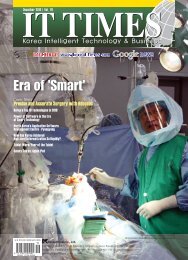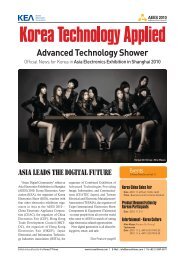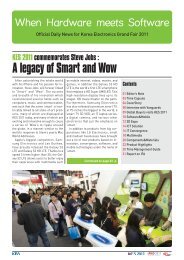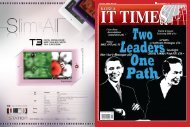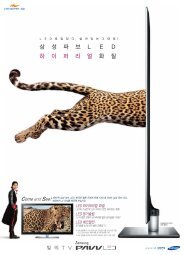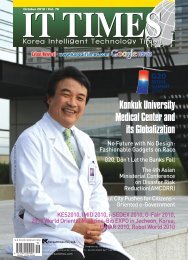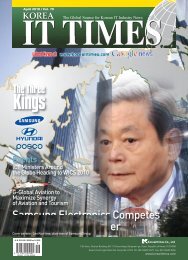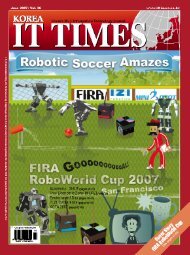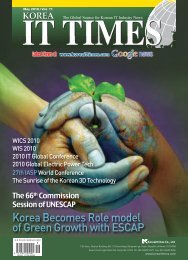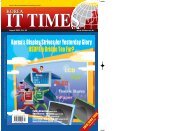2010-07 - Korea IT Times
2010-07 - Korea IT Times
2010-07 - Korea IT Times
You also want an ePaper? Increase the reach of your titles
YUMPU automatically turns print PDFs into web optimized ePapers that Google loves.
Column<br />
Computer United,<br />
The Republic of <strong>Korea</strong><br />
ByChoiSeong<br />
(sstar@nsu.ac.kr)<br />
Dr. Choi Seong, Professor of Computer Science at<br />
Namseoul University<br />
As the separation of the division between<br />
the North and South <strong>Korea</strong> is becoming<br />
more firm, their everyday language<br />
and even the technical languages<br />
are becoming more different every day.<br />
Language is important in suggesting actions,<br />
so it is important to organize a unification<br />
of languages between the people of<br />
North and South <strong>Korea</strong>. Especially the<br />
rapidly changing <strong>IT</strong> language which is<br />
very different in each country.<br />
In this sense, it is preferable that the<br />
North and South scholars are contacting<br />
each other, such as opening seminars regarding<br />
the unification of the <strong>IT</strong> language.<br />
Pondering and solving such problems in<br />
everyday lives, together, can also speed up<br />
the unification. The most important thing<br />
in the <strong>IT</strong> area is the unification of the basic<br />
keyboard to enter data into the computer.<br />
The most crucial thing in character management<br />
in the computers is the typing<br />
characters. There was a technology called<br />
the "mechanization of <strong>Korea</strong>n" in the<br />
typewriter era. A representative example is<br />
the <strong>Korea</strong>n typewriter that copied the mechanical<br />
shapes of English typewriters in<br />
the 1950s. From the invention of such<br />
<strong>Korea</strong>n typewriters, many people have<br />
been experiencing the battles between the<br />
2 rows, 3 rows, or the 4 rows arrangements<br />
for about 30 years. That is because<br />
the keyboard arrangement or the entering<br />
technology is that important. However,<br />
North <strong>Korea</strong> is showing much effort in developing<br />
<strong>IT</strong> personnel to advance the <strong>IT</strong><br />
industry. What is the computer keyboard<br />
that is used in North <strong>Korea</strong> that is dreaming<br />
of the huge leap in the <strong>IT</strong> industry?<br />
First, the arrangement is different. In<br />
North <strong>Korea</strong>, the computer keyboard is<br />
normally called a keyboard. North and<br />
South <strong>Korea</strong> both use the 2 row systems<br />
that do not distinguish between the initial<br />
sounds and the last sound and the consonants<br />
are on the left side and the vowels<br />
are on the right side. However, the alphabet<br />
arrangement is different from South<br />
<strong>Korea</strong>'s.<br />
The reason the alphabet arrangements<br />
are different is because North <strong>Korea</strong> does<br />
not apply the rules regarding the initial<br />
sound of the syllable and use the consonants,<br />
such as the L and N quite often and<br />
have placed these consonants in the middle.<br />
The cause is the difference between<br />
the languages of the South and the North<br />
<strong>Korea</strong>. Also, in the arrangement order,<br />
South <strong>Korea</strong> generally organizes them in<br />
the orders of the shape of the characters<br />
but North <strong>Korea</strong> is using the phonetic value<br />
orders. The shape of the North <strong>Korea</strong>n<br />
keyboard according to the national criteria<br />
(KPS) was compared with the South<br />
<strong>Korea</strong>n keyboard in the figure. North<br />
<strong>Korea</strong> has established the "Morning-<br />
Panther Computer cooperative company"<br />
to assemble and sell the computers, but because<br />
of the low hardware production,<br />
majority of the keyboards are foreignmade.<br />
Therefore, the majority of the keyboards<br />
used have the English alphabets<br />
but the <strong>Korea</strong>n alphabets are not shown<br />
on the keyboard. Therefore, most of the<br />
computer users are using the keyboard by<br />
memorizing the order. Just like when we<br />
prepared for the music test by drawing the<br />
piano keyboard onto a piece of paper because<br />
there were very few pianos, the<br />
North <strong>Korea</strong>n students practice their typing<br />
by drawing the keyboard on the pieces<br />
of paper. Also, on the North <strong>Korea</strong>n keyboard,<br />
there is no <strong>Korea</strong>n/ English converting<br />
key or a Chinese character converting<br />
key.<br />
If we were to achieve unification unexpectedly,<br />
it becomes a serious problem<br />
when computer keyboards are not unified<br />
between North and the South <strong>Korea</strong>. If<br />
the language and the entering system are<br />
different, then it can cause chaos, just like<br />
we experienced in the earlier stages of<br />
computer distribution.<br />
A scientific arrangement and education<br />
of the computer keyboards are an important<br />
basic technology in the <strong>IT</strong> era. Therefore,<br />
the <strong>Korea</strong>n Language Information<br />
Association and the North <strong>Korea</strong>n Language<br />
Association and Chinese <strong>Korea</strong>n<br />
Language Associations have been carrying<br />
out much interaction and cooperation<br />
with the linguists and information technology<br />
experts to establish the standards of<br />
<strong>Korea</strong>n arrangement and a unified keyboard<br />
since the mid-90s.<br />
However, the keyboard and entering<br />
codes have not been established as a national<br />
standard for the whole of <strong>Korea</strong>.<br />
We need continuous exchange, conversations<br />
and cooperation among the South,<br />
North and the Chinese (Chosun people)<br />
more than before.<br />
It would be preferable to distribute the<br />
<strong>Korea</strong>n computer unified keyboard under<br />
the agreement of the <strong>Korea</strong>n <strong>IT</strong> scholars in<br />
South, North and the Chinese (Chosun)<br />
<strong>Korea</strong>. Also, if possible, hosting a South,<br />
North and Chinese "<strong>Korea</strong>n unified computer<br />
keyboard competition" is a solution<br />
to unify the alienated language cultures.<br />
64 KOREA <strong>IT</strong> TIMES | July <strong>2010</strong>



